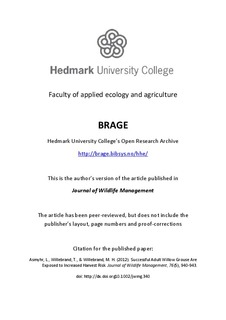Successful Adult Willow Grouse Are Exposed to Increased Harvest Risk
Original version
Asmyhr, L., Willebrand, T., & Willebrand, M. H. (2012). Successful Adult Willow Grouse Are Exposed to Increased Harvest Risk. Journal of Wildlife Management, 76(5), 940-943. doi: http://dx.doi.org10.1002/jwmg.340 http://dx.doi.org/10.1002/jwmg.340Abstract
Age and sex ratios in bag records are frequently used as indices of population composition for harvested populations. However, vulnerability to harvest may differ by age and sex thereby producing bias in population estimates. We assessed whether age and sex affected vulnerability to harvest for willow grouse (Lagopus lagopus) where adult density and brood size were known in the harvested populations. We collected bag records during 2 days of controlled hunting in 4 areas in 2 years (2007 and 2008) in Jämtland county, Sweden. We found that vulnerability to harvest was different for chicks and adults, but not between male and female adults. Hunters encountered broods at a higher rate than single birds compared to personnel conducting pre-harvest counts along line transects. Furthermore, the probability of shooting a grouse was higher in encounters of broods than individual grouse. Proportionally, we calculated about a 50% probability of a hunter shooting either a chick or an adult independent of encountering a single bird or broods of 2–10 grouse. Increasing adult density also increased the vulnerability to harvest for adults relative to chicks, independent of the chick to adult ratio in the pre-harvest population. The different vulnerability of adults and chicks to harvest observed in this study will dampen variation in age classes in bag records compared to the population, and we caution against extrapolation of age ratios in bag records to harvested populations
Description
This is the postprint version of the article. The published version of the article can be located at the publisher's webpage
